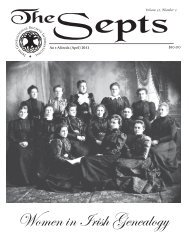(April) 2011 - Irish Genealogical Website International
(April) 2011 - Irish Genealogical Website International
(April) 2011 - Irish Genealogical Website International
Create successful ePaper yourself
Turn your PDF publications into a flip-book with our unique Google optimized e-Paper software.
_________________________________________________________________ Beginning Genealogy<br />
Julia Kemp Fawkner<br />
Sometimes we wonder where an ancestor’s daughter went. James<br />
C. Fawkner of Coles County, Illinois, had a daughter Julia Kemp<br />
Fawkner, who was born about 1867 in Missouri. She was single<br />
and living at home in Coles County in 1880, but the family had<br />
vanished from Coles County by 1900. Julia had a brother named<br />
Cyrus, born about 1870 in Missouri. A search of the Ancestry.<br />
com 1900 census index led to a 31-year-old, Missouri-born Cyrus<br />
Falkner living in Duluth, Minnesota. The census-taker identified<br />
him as the brother-in-law of the head of the household: George<br />
Watson. George’s wife was Julia K., born in Missouri in 1867. Case<br />
solved: Julia Kemp Fawkner married George Watson and moved to<br />
Minnesota.<br />
Reversing direction. In researching the ancestry of Mrs. Julia<br />
Watson, we can work the problem back in time. Julia died sometime<br />
after February 1952, possibly in Milwaukee, but we don’t have an<br />
obituary or death certificate. The presence of brother-in-law Cyrus<br />
Falkner in Julia’s home in 1900 implies that Julia was a Falkner.<br />
Now we can use census indexes to try to locate either George and/<br />
or Julia in earlier censuses in hopes of finding a likely marriage<br />
location. The 1900 Census helps because it states that George and<br />
Julia had been married 10 years. The oldest of three children was<br />
born in Colorado – but that is probably a red herring; the marriage<br />
more likely occurred in or near Douglas County, Illinois, where<br />
both George and Julia lived as teenagers.<br />
No death certificate? No marriage certificate? No problem: follow<br />
the children. The Watsons had a son, George Cecil Watson,<br />
whose 1964 death certificate states that his mother’s maiden name<br />
was Julia K. Faulkner. George was buried in Waukesha County,<br />
<strong>Irish</strong> <strong>Genealogical</strong> Society <strong>International</strong><br />
Moultrie County, Illinois<br />
1850 U.S. Census<br />
Mumphred Fortiner, 40, b. Va.<br />
Elizabeth, 42, b. Ky<br />
John C., 14, b. Ind.<br />
Henry, 12, b. Ind.<br />
James, 10, b. Ind.<br />
Wisconsin, again pointing to the Milwaukee<br />
area as a possible place to find Julia’s death<br />
information.<br />
Elizabeth Faulkner<br />
Before 1880, U.S. censuses did not identify<br />
family relationships. The 1870 Putnam<br />
County, Indiana, census enumeration finds<br />
Thomas, 15, born in Indiana, along with his<br />
sisters Margaret and Clarinda, all living in<br />
the household of James Darraugh, 51, and<br />
his wife Evaline, 48. The Faulconer children<br />
are clearly not from an earlier marriage of<br />
Evaline because Margaret and Thomas are<br />
older than two of the Darraugh children.<br />
Although we can not assume they were<br />
related to the Darraughs,the Faulconer children may be nephews and<br />
nieces of either James or Evaline, or possibly even grandchildren.<br />
Putnam County, Indiana<br />
1860 U.S. Census<br />
Jas. Darraugh, 51,<br />
b. Kentucky<br />
Evaline Darraugh, 48,<br />
b. Kentucky<br />
Jeptha Darraugh, 26,<br />
b. Kentucky<br />
Whitfield Darraugh, 20,<br />
b. Kentucky<br />
Nancy Darraugh, 16,<br />
b. Kentucky<br />
Lewis Darraugh, 14,<br />
b. Kentucky<br />
Peggy Darraugh, 88,<br />
b. Kentucky<br />
Margrett, 7, b. Ind. Margret J. Faulkner, 17,<br />
b. Indiana<br />
Thos F., 5, b. Ind. Thomas J. Faulkner, 15,<br />
b. Indiana<br />
Clarinda, 2, b. Ind. Clarinda A. Faulkner, 12,<br />
b. Indiana<br />
Note: 1860 enumerator used ditto marks (“) to indicate surnames of wives and<br />
children.<br />
Page 79




